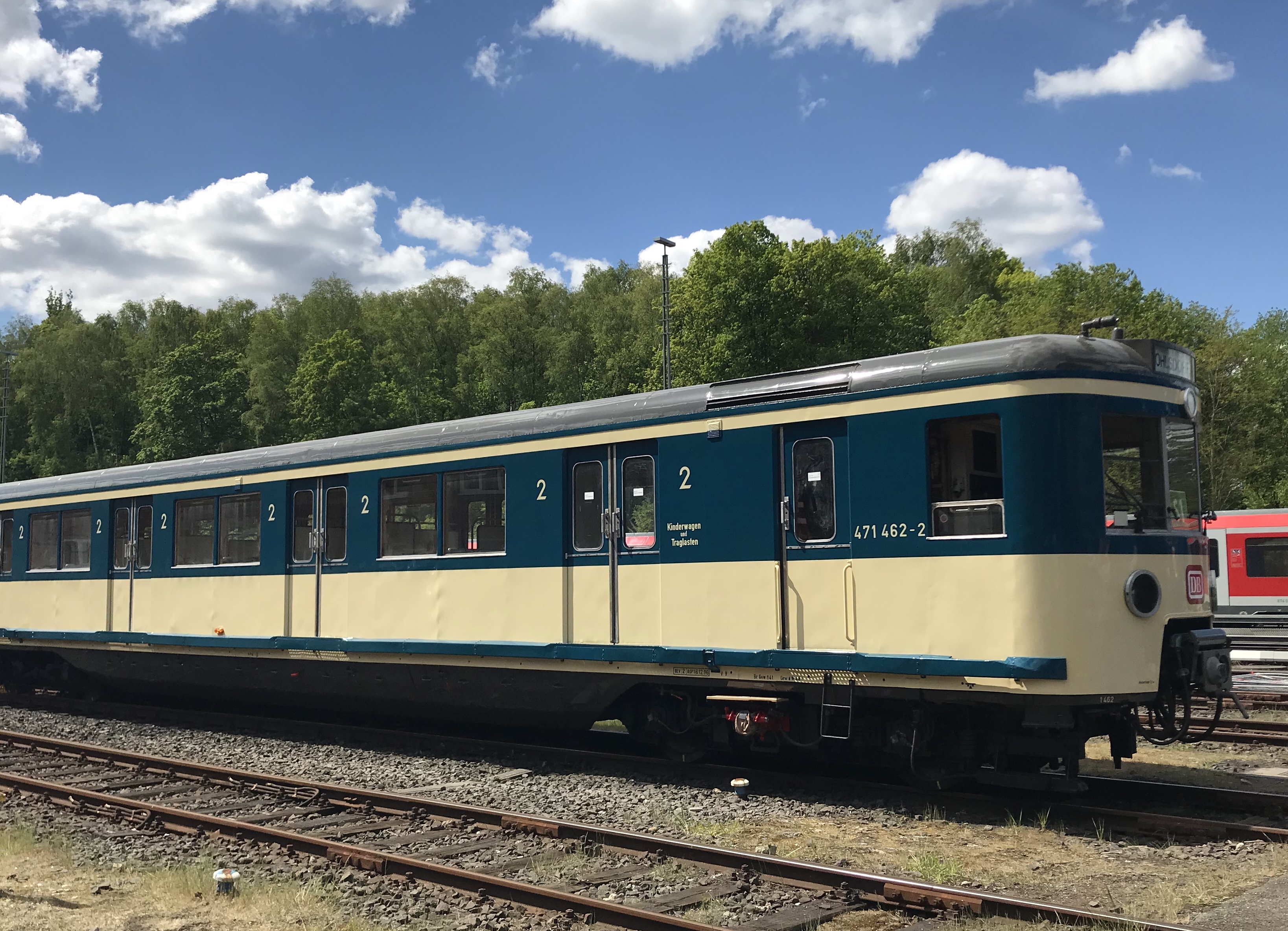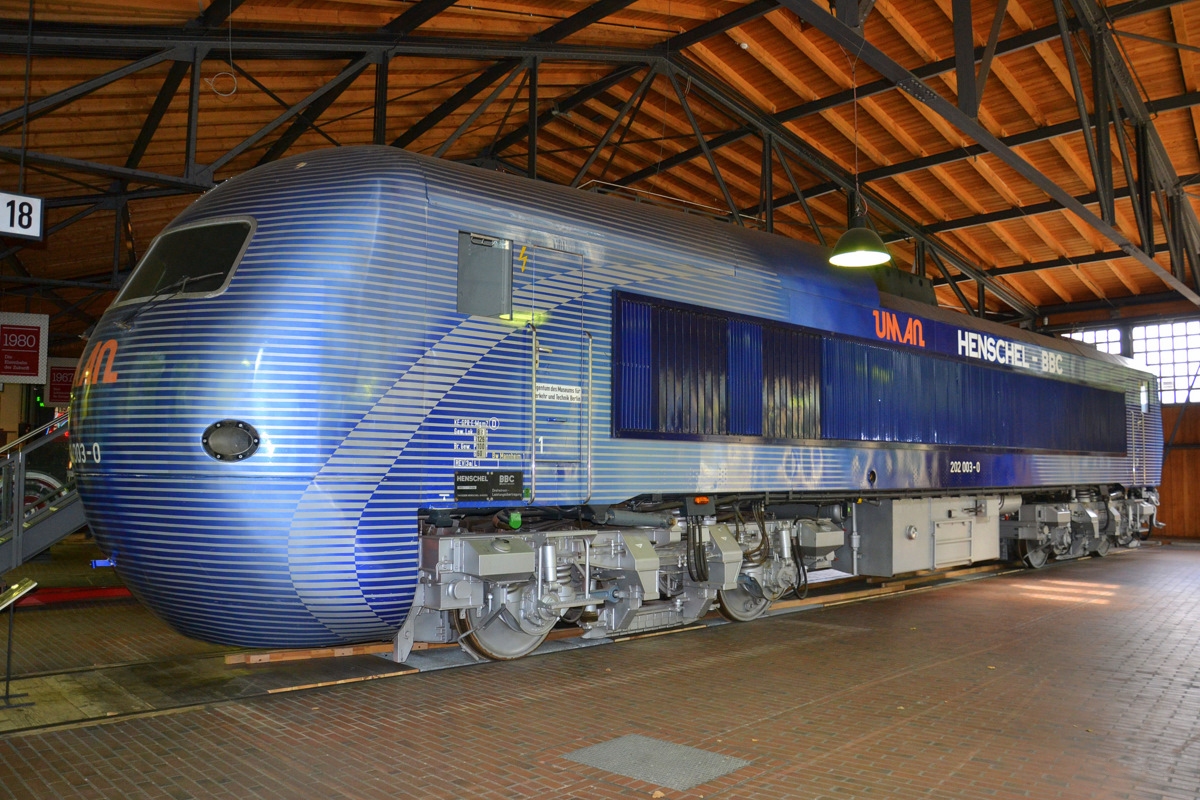|
DB Class 471
The DRG Class ET 171 (since 1968 DB Class 471/871) was a three-car electric multiple unit built for the S-Bahn Hamburg (rapid transit railway). History The first electrically operated Hamburg S-Bahn trains had appeared on the Hamburg-Altona City and Suburban Railway in 1907. In 1937, the main-line railway operator, Deutsche Reichsbahn, decided to switch current collection from overhead catenary ( AC 6,3 kV/25 Hz) to third rail ( DC 1,2 kV), basically adopting the S-Bahn system established in Berlin from 1924 onwards. The new class ET 171 trains were built to replace antiquated overhead stock based on non-corridor coaches. The first ET 171 unit appeared in Hamburg in December 1939. :de:DRG-Baureihe ET 171Translation from the German Wikipedia article Between then and 1943 further 46 trainsets were built. They received a distinctive dark blue livery with a broad cream stripe on the centre car to denote the 2nd (from 1955: 1st) class. Production was halted by World War II. I ... [...More Info...] [...Related Items...] OR: [Wikipedia] [Google] [Baidu] |
Aumühle
Aumühle () is a municipality in Schleswig-Holstein in northern Germany, about 21 km (14 mi) east of Hamburg. Its Friedrichsruh district is home to the family estate and mausoleum of Otto von Bismarck. Geography Aumühle lies on the river Bille in the Sachsenwald, the largest forest in Schleswig-Holstein. History In 1350 Aumühle was first mentioned in writing as ''Au-Mühle'' (mill on the river Au). In 1846, a station on the newly-constructed Hamburg-Berlin railway line was opened at Friedrichsruh. Aumühle station itself was added in 1884. In 1871 Kaiser Wilhelm I of Germany gifted the Sachsenwald forest, adjacent to the Au, to Otto von Bismarck in recognition of his services to the newly unified German nation. Bismarck had a manor house built there, opting to retain the historic name of Friedrichsruh. Bismarck now lies buried in the Bismarck Mausoleum situated there. Karl Dönitz, the last head of state of Nazi Germany, moved to Aumühle after his release ... [...More Info...] [...Related Items...] OR: [Wikipedia] [Google] [Baidu] |
Overhead Line
An overhead line or overhead wire is an electrical cable that is used to transmit electrical energy to electric locomotives, trolleybuses or trams. It is known variously as: * Overhead catenary * Overhead contact system (OCS) * Overhead equipment (OHE) * Overhead line equipment (OLE or OHLE) * Overhead lines (OHL) * Overhead wiring (OHW) * Traction wire * Trolley wire This article follows the International Union of Railways in using the generic term ''overhead line''. An overhead line consists of one or more wires (or rails, particularly in tunnels) situated over rail tracks, raised to a high electrical potential by connection to feeder stations at regular intervals. The feeder stations are usually fed from a high-voltage electrical grid. Overview Electric trains that collect their current from overhead lines use a device such as a pantograph, bow collector or trolley pole. It presses against the underside of the lowest overhead wire, the contact wire. Current collectors ar ... [...More Info...] [...Related Items...] OR: [Wikipedia] [Google] [Baidu] |
Driving Unit From EMU 471 062
Driving is the controlled operation and movement of a vehicle, including cars, motorcycles, trucks, buses, and bicycles. Permission to drive on public highways is granted based on a set of conditions being met and drivers are required to follow the established road and traffic laws in the location they are driving. The word driving, has etymology dating back to the 15th century and has developed as what driving has encompassed has changed from working animals in the 15th to automobiles in the 1800s. Driving skills have also developed since the 15th century with physical, mental and safety skills being required to drive. This evolution of the skills required to drive have been accompanied by the introduction of driving laws which relate to not only the driver but the driveability of a car. Etymology The origin of the term ''driver'', as recorded from the 15th century, refers to the occupation of driving working animals, especially pack horses or draft horses. The verb ' ''t ... [...More Info...] [...Related Items...] OR: [Wikipedia] [Google] [Baidu] |
German Museum Of Technology
(German Museum of Technology) in Berlin, Germany is a museum of science and technology, and exhibits a large collection of historical technical artifacts. The museum's main emphasis originally was on rail transport, but today it also features exhibits of various sorts of industrial technology. In 2003, it opened both maritime and aviation exhibition halls in a newly built extension. The museum also contains a science center called Spectrum. History The Museum of Traffic and Technology (') was founded in 1982 and assumed the tradition of the Royal Museum of Traffic and Construction (') which was opened in the former station building in 1906. The present-day museum is located on the former freight yard attached to the in the district of Berlin, including two historic roundhouses and several office buildings. Renamed ' in 1996, the exhibition area was gradually expanded. An adjacent new building complex was inaugurated in 2003, topped by a prominent US Air Force Douglas C-47B ... [...More Info...] [...Related Items...] OR: [Wikipedia] [Google] [Baidu] |
Salzgitter
Salzgitter (; Eastphalian: ''Soltgitter'') is an independent city in southeast Lower Saxony, Germany, located between Hildesheim and Braunschweig. Together with Wolfsburg and Braunschweig, Salzgitter is one of the seven ''Oberzentren'' of Lower Saxony (roughly equivalent to a metropolitan area). With 101,079 inhabitants and (as of 31 December 2015), its area is the largest in Lower Saxony and one of the largest in Germany. Salzgitter originated as a conglomeration of several small towns and villages, and is today made up of 31 boroughs, which are relatively compact conurbations with wide stretches of open country between them. The main shopping street of the young city is in the borough of Lebenstedt, and the central business district is in the borough of Salzgitter-Bad. The city is connected to the Mittellandkanal and the Elbe Lateral Canal by a distributary. The nearest metropolises are Braunschweig, about to the northeast, and Hanover, about to the northwest. The population ... [...More Info...] [...Related Items...] OR: [Wikipedia] [Google] [Baidu] |
Heritage Train
Conservation and restoration of rail vehicles aims to preserve historic rail vehicles. Trains It may concern trains that have been removed from service and later restored to their past condition, or have never been removed from service, like UP 844, the only U.S. steam locomotive to never be retired. They are often operated in present-day service as moving examples of living history, as opposed to static exhibits. The majority of restored trains are operated at heritage railways and railway museums, although they can also be found on the main lines or branch lines of the commercial working railway, operated by specialist railtour companies or museum groups. For authenticity, the location/route of preserved trains is often chosen to match the original trains used. Heritage railways and railway museums aim to restore and operate restored trains. Trains are often restored to the original authentic livery of their original owner. In the United States The restoration of historic r ... [...More Info...] [...Related Items...] OR: [Wikipedia] [Google] [Baidu] |
DBAG Class 474
The DBAG Class 474/874 is a three-car electric multiple unit train for the Hamburg S-Bahn. The class 474 were built to replace the nearly-60-year-old class 471 trains. Some units have a pantograph (''474.3'') to service the 2007 opened line to Stade on an overhead catenary track. History The first series of 45 vehicles were ordered in 1994 from Linke-Hofmann-Busch as consortium leader of the Linke-Hofmann-Busch consortium and the then ABB Henschel in Salzgitter. Delivery started in 1996 and the first train was presented to the press in 1997. The second series of 58 vehicles were ordered in 1996 and delivered to Bw Hamburg-Ohlsdorf by 2001. In 2016, the first 474s were converted to 474-Plus railcars. The conversion was completed on December 20, 2021. Technology The class 474 represents a generation change in vehicles at the Hamburger S-Bahn. As before, the power is fed in via a third rail on the side of the track. The vehicles are supplied with direct current at 1,200 Volts. F ... [...More Info...] [...Related Items...] OR: [Wikipedia] [Google] [Baidu] |
DB Class 472
The DB Class 472/473 is a three-car electric multiple unit train for the Hamburg S-Bahn The Hamburg S-Bahn is a suburban commuter railway network in the Hamburg Metropolitan Region. Together, the S-Bahn, the Hamburg U-Bahn, the AKN railway and the regional railway form the backbone of railway public transport in the city and the s .... They were built to service the new lines through the city tunnel (opened 1975), to Harburg (opened 1983) and to Neugraben (opened 1984). The livery was beige blue at first, but it was changed to ''verkehrsrot'' (traffic-red) in 1997. :de:DB-Baureihe 472Translation from the German Wikipedia article The Class 473 is the centre carriage of the Class 472, it differs from the predecessor (470 and 471) centre carriages in its own electric motors and they have three door pairs instead of four. In 2012, 52 units survived from a total of 62 built. Replacement units are on order as part of the January 2012 tendering of the S-Bahn network, due to run from ... [...More Info...] [...Related Items...] OR: [Wikipedia] [Google] [Baidu] |
Hamburg Central Station
Hamburg Hauptbahnhof (abbrev. ''Hamburg Hbf'') is the main railway station of the city of Hamburg, Germany. Opened in 1906 to replace four separate terminal stations, today Hamburg Hauptbahnhof is operated by DB Station&Service AG. With an average of 550,000 passengers a day, it is Germany's busiest railway station and the second-busiest in Europe after the Gare du Nord in Paris. It is classed by Deutsche Bahn as a category 1 railway station. The station is a through station with island platforms and is one of Germany's major transportation hubs, connecting long-distance Intercity Express routes to the city's U-Bahn and S-Bahn rapid transit networks. It is centrally located in Hamburg in the Hamburg-Mitte borough. The ''Wandelhalle'' shopping centre occupies the north side of the station building. History Before today's central station was opened, Hamburg had several smaller stations located around the city centre. The first railway line ( between Hamburg and Bergedorf) was ... [...More Info...] [...Related Items...] OR: [Wikipedia] [Google] [Baidu] |
World War II
World War II or the Second World War, often abbreviated as WWII or WW2, was a world war that lasted from 1939 to 1945. It involved the vast majority of the world's countries—including all of the great powers—forming two opposing military alliances: the Allies and the Axis powers. World War II was a total war that directly involved more than 100 million personnel from more than 30 countries. The major participants in the war threw their entire economic, industrial, and scientific capabilities behind the war effort, blurring the distinction between civilian and military resources. Aircraft played a major role in the conflict, enabling the strategic bombing of population centres and deploying the only two nuclear weapons ever used in war. World War II was by far the deadliest conflict in human history; it resulted in 70 to 85 million fatalities, mostly among civilians. Tens of millions died due to genocides (including the Holocaust), starvation, ma ... [...More Info...] [...Related Items...] OR: [Wikipedia] [Google] [Baidu] |


.jpg)



